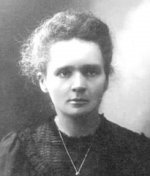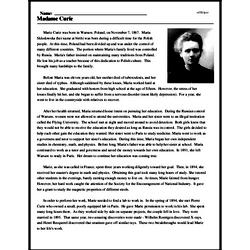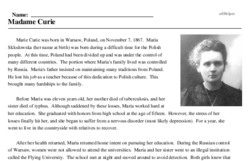Madame Curie
Marie Curie
Reading Comprehension for November 7
Marie Curie was born in Warsaw, Poland, on November 7, 1867. Maria Sklodowska (her name at birth) was born during a difficult time for the Polish people. At this time, Poland had been divided up and was under the control of many different countries. The portion where Maria's family lived was controlled by Russia. Maria's father insisted on maintaining many traditions from Poland. He lost his job as a teacher because of this dedication to Polish culture. This brought many hardships to the family.
Before Maria was eleven years old, her mother died of tuberculosis, and her sister died of typhus. Although saddened by these losses, Maria worked hard at her education. She graduated with honors from high school at the age of fifteen. However, the stress of her losses finally hit her, and she began to suffer from a nervous disorder (most likely depression). For a year, she went to live in the countryside with relatives to recover.
After her health returned, Maria returned home intent on pursuing her education. During the Russian control of Warsaw, women were not allowed to attend the universities. Maria and her sister went to an illegal institution called the Flying University. The school met at night and moved around to avoid detection. Both girls knew that they would not be able to receive the education they desired as long as Russia was in control. The girls decided to help each other gain the education they wanted. Her sister went to Paris to study medicine. Maria went to work as a governess and tutor to support her sister's education. During this time, Maria began her own independent studies in chemistry, math, and physics. Before long, Maria's father was able to help her sister at school. Maria continued to work as a tutor and governess and saved the money towards her own education. In 1891, she left Warsaw to study in Paris. Her dream to continue her education was coming true.
Marie, as she was called in France, spent three years working diligently toward her goal. Then, in 1894, she received her master's degree in math and physics. Obtaining this goal took many long hours of study. She tutored other students in the evenings, barely earning enough money to live on. At times, Marie fainted from hunger. However, her hard work caught the attention of the Society for the Encouragement of National Industry. It gave her a grant to study the magnetic properties of different steels.
In order to perform her work, Marie needed to find a lab to work in. In the spring of 1894, she met Pierre Curie who owned a small, poorly equipped lab in Paris. He gave Marie permission to work in his lab. She spent many long hours there. As they worked side by side on separate projects, the couple fell in love. They were married in 1895. That same year, two amazing discoveries were made - Wilhelm Roentgen discovered X-rays, and Henri Becquerel discovered that uranium gave off similar rays. These two breakthroughs would lead Marie to her life's work.




